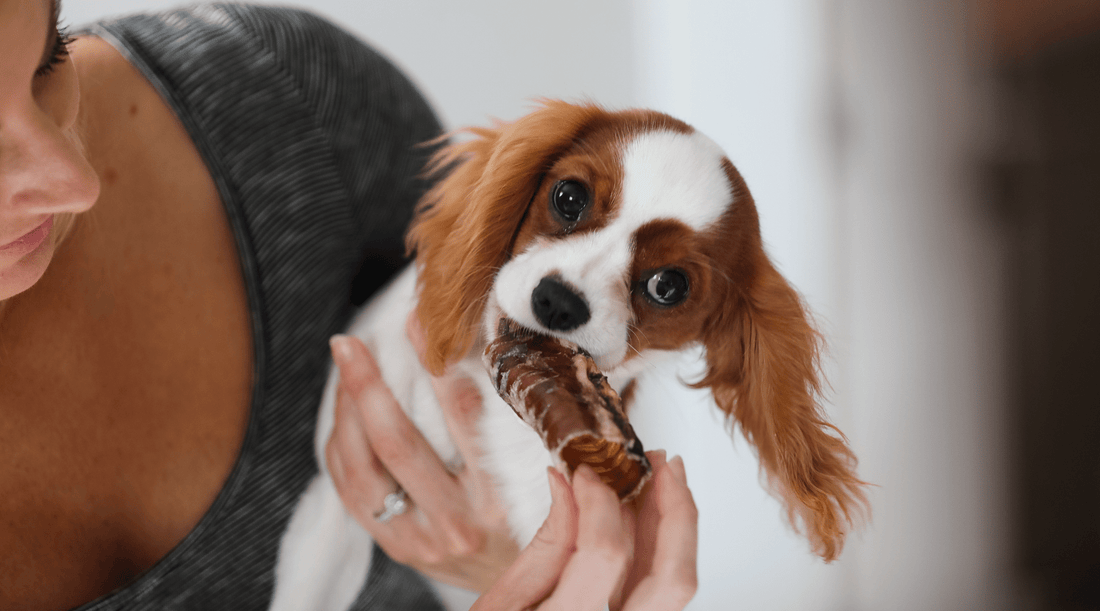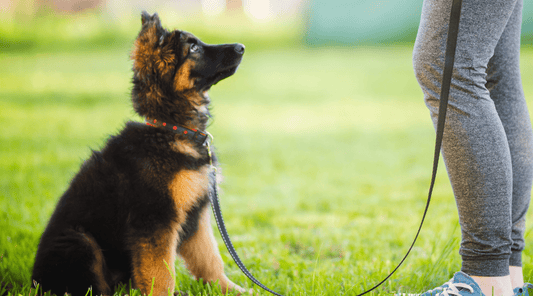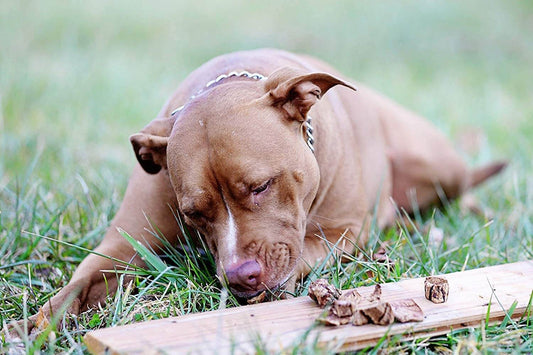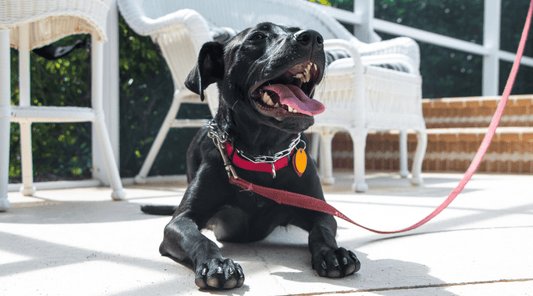
How to Stop Puppy Biting: Gentle Yet Effective Methods
Dawn Miller Jan 09, 20255 Minute ReadWhen you first get a puppy, it seems like all fun and games—so much energy, love, and cuddles. But often, another behavior emerges at around 3 months—puppy biting.
Will they grow out of it? Can you learn how to stop puppy biting?
The other afternoon, I was doing dishes when the doorbell camera alerted me of a visitor. Wiping my hands on a clean towel, I headed toward the door to find my teenage neighbor, Noah, with his new American Bully puppy, Cam, in tow.
Noah looked exhausted as he explained that Cam was biting everything in sight—shoes, hands, furniture. Nothing was safe.
His mom told him I was the neighborhood dog whisperer and might be able to help.
Five-month-old Cam wasted no time proving what Noah told me was true. As the little guy went for my shoelaces, I reached for a chew toy to redirect his energy.
“Don’t worry,” I said. “Puppy biting is totally normal. We can help him learn what’s okay to chew on and what’s not.”
Why Do Puppies Bite?
Puppies don’t bite because they’re “bad.” In fact, biting is a completely natural part of their development. It's part of how puppies explore their world. Dogs use their mouth to grab, chew, tug, and experience the world—because they don't have opposable thumbs to pickup and break things—as a toddler would.
They just don't know any better and don't realize that it hurts humans who don't have a mound of fur to protect us. But there are some other reasons to be aware of:
- Teething Pain Relief. Between 3 and 5 months, puppies go through teething. Biting helps soothe their sore gums so those new teeth emerge.
- Play Behavior. Puppies nip during play, especially with their littermates. It’s how they interact, learn boundaries, and burn off a truck-load of energy. In this case, Noah chose Cam from a friend's litter. Cam no longer has littermates with whom to play. So, Noah has become his "bite buddy".
- Attention-Seeking. Sometimes, biting is just a way to get your attention. Even a “No!” can feel rewarding to a puppy craving more excitement. Negative responses like this can often have the opposite effect. This is what led Noah to visit me. He felt like he'd said "no" a million times and got more biting, not less.
Do Puppies Grow Out of Biting?
Typically, puppy biting significantly decreases by 5-6 months. But if the behavior was reinforced, they might bite for much longer.
And I'll tell you it's hard not to reinforce it when you have a furry tornado tearing through your sneaker collection and trying to swallow anything they can get into their mouths.
With that in mind, it's essential to start training your puppy early. You can communicate in a language they understand what is okay to chew on. This is how to stop puppy biting for good.
How to Train a Puppy to Stop Biting
As Noah and I sat down to chat, Cam enthusiastically began gnawing on the corner of my coffee table. It was the perfect opportunity to offer some practical advice. Here are the steps I shared with Noah to help guide Cam away from biting behaviors.
1. Yelp Like a Dog...Sort of
When Cam bit down too hard on Noah's hand during play, I explained how he could mimic what Cam’s littermates would do. A high-pitched “yelp” or a firm “Ouch!” signals to the puppy that they’ve gone too far. Puppies instinctively stop because they don't want to hurt their friends.
You're speaking Puppy. It works better than "no" because these tender-hearted babies know what a yelp of pain is.
As Cam tried to chew on my coffee table, which had already seen better days, I demonstrated. Cam froze for a second, clearly surprised.
This gave me a window for the next step in how to train a puppy to stop biting.
2. Redirect to an Appropriate Chew Toy
"I want to avoid reinforcing the behavior, so I make them stop first with a yelp sound." I explained. “Now, let’s show him what he can chew on.” I handed Cam a soft puppy chew toy from my basket. He immediately latched onto it, happy to have something softer to gnaw on.
I shared with Noah that puppies don’t know what’s off-limits unless we show them. Chews like dog toys can help. More substantial dog treats and dog bones are even better. They provide a socially acceptable and healthier outlet for chewing.
3. Teach Bite Inhibition
Bite inhibition is all about teaching puppies to control the force of their bite. I showed Noah how to stop playtime immediately if Cam bit too hard. This "time out" may seem like the opposite of positive reinforcement training.
But you're just making sure you don't reward their actions. Ignoring a puppy—even for several seconds—further communicates that what they did isn't okay.
“When he calms down, start playing again,” I said. “This teaches him that gentle play gets rewarded. But rough play ends the fun.”
4. Reward Good Behavior
Now, onto the good stuff...rewards. Positive reinforcement training helps dogs generate good feelings around behaving well or performing learned skills.
When Cam chewed on his toy instead of Noah’s shoelaces, we praised him and gave him a small treat. “Reinforce the good stuff,” I said. "You'll get more of it."
That's a life lesson that goes beyond how to train a puppy to stop biting.
I told Noah that I choose beef lung bites for training puppies. They're single-ingredient, roasted organ meat from grass-fed beef herds. They are perfectly dry, so they break into smaller pieces. One bag can support hours and hours of training—in puppy-friendly 5-minute windows, of course.
Beef lung bites are amazing for quick training treats. They're irresistible and don't smell bad. Dogs will learn backflips for these treats.
But they also need something to chew on.
5. Give Them Healthy Chews for Puppies on a Schedule
Noah is a busy teenager—between school and practice and friends. Still, I encouraged him to find a consistent time, just 15-20 minutes a few times a week, when he could sit down with Cam and let him enjoy a longer-lasting chew treat, like beef trachea or an all-natural beef marrow dog bone. These are perfect chews for puppies (that have their adult teeth) because there's no weird stuff on the label. Just whole food dog treats!
Chew time becomes both quality time and gives Cam time to chew on something that is both healthy and supportive of his teeth and gums. He learns to look forward to these regularly scheduled chew sessions and is less likely to look for things to chew on in between.
Plus, beef trachea and the bone marrow in marrow bones are superfoods for dogs with collagen protein, healthy omega 3 fat, and lots of vitamins and minerals.
I even shared how he can make these treats last a very long time by freezing them in between uses.
Patience and Persistence Pay Off in Dog Training
Training a puppy like Cam to stop biting takes time, patience, and consistency. But with the right techniques and plenty of healthy dog treats and dog bones, the biting phase will pass, leaving behind a well-behaved and happy dog.
To learn more about puppy training for the win, I encourage you to check out this Free 7-Day Dog Training Challenge.
Available On:





